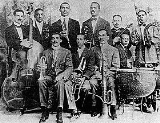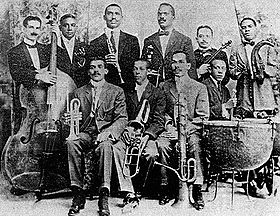
Enrique Peña
Encyclopedia
Enrique Peña Sánchez was a leading Cuban
cornet
player, orchestra leader and composer.
Born in a small town in the old province of Oriente, Peña studied with Marcos González and José Santos Betancourt. In 1902 he moved to Havana, and founded the band La Juventud, with himself as director and cornet, Rogelio Solis (double bass
), Félix González (figle
), José Belén Puig (first clarinet
), José Urfé
(second clarinet), José de los Reyes (kettle drum) and Rufino Cárdenas (güiro
). This band had several members who became well known; Puig went on to become a famous leader of his own charanga
. The band functioned until 1906.
 His second band was called the Orquesta típica
His second band was called the Orquesta típica
de Enrique Peña. Its line-up was Peña (cornet); Antonio González (trombone); Féliz González (figle); José Belén Puig (1st clarinet); José Urfé (2nd clarinet); Julián Barreto (violin); Alfredo Sáenz (violin); José de los Reyes (tympani); Rufino Cárdenas (güíro) and unknown (double bass). This orchestra became famous for being the first to play El bombín de Barreto (Barreto's bowler hat), written by Urfé, which was supposedly the first danzón
to incorporate a syncopated third part, influenced by the son. The group recorded about 150 numbers, some of which are available on CD.
Peña was a prolific composer of danzones, amongst which are El ñáñigo, El dengue, El demonio de la negra, La flor de Cuba, Malabares and Edén concert.
Cubans
Cubans or Cuban people are the inhabitants or citizens of Cuba. Cuba is a multi-ethnic nation, home to people of different ethnic and national backgrounds...
cornet
Cornet
The cornet is a brass instrument very similar to the trumpet, distinguished by its conical bore, compact shape, and mellower tone quality. The most common cornet is a transposing instrument in B. It is not related to the renaissance and early baroque cornett or cornetto.-History:The cornet was...
player, orchestra leader and composer.
Born in a small town in the old province of Oriente, Peña studied with Marcos González and José Santos Betancourt. In 1902 he moved to Havana, and founded the band La Juventud, with himself as director and cornet, Rogelio Solis (double bass
Double bass
The double bass, also called the string bass, upright bass, standup bass or contrabass, is the largest and lowest-pitched bowed string instrument in the modern symphony orchestra, with strings usually tuned to E1, A1, D2 and G2...
), Félix González (figle
Ophicleide
The ophicleide is a family of conical bore, brass keyed-bugles. It has a similar shape to the sudrophone.- History :The ophicleide was invented in 1817 and patented in 1821 by French instrument maker Jean Hilaire Asté as an extension to the keyed bugle or Royal Kent bugle family...
), José Belén Puig (first clarinet
Clarinet
The clarinet is a musical instrument of woodwind type. The name derives from adding the suffix -et to the Italian word clarino , as the first clarinets had a strident tone similar to that of a trumpet. The instrument has an approximately cylindrical bore, and uses a single reed...
), José Urfé
José Urfé
José Urfé González was a Cuban clarinetist and composer. He introduced a new musical element from the son into the danzón in 1910....
(second clarinet), José de los Reyes (kettle drum) and Rufino Cárdenas (güiro
Güiro
The güiro is a Latin-American percussion instrument consisting of an open-ended, hollow gourd with parallel notches cut in one side. It is played by rubbing a stick or tines along the notches to produce a ratchet-like sound. The güiro is commonly used in Latin-American music, and plays a key role...
). This band had several members who became well known; Puig went on to become a famous leader of his own charanga
Charanga
Charanga is a term given to traditional ensembles of Cuban dance music. They made Cuban dance music popular in the 1940s and their music consisted of heavily son-influenced material, performed on European instruments such as violin and flute by a Charanga orchestra....
. The band functioned until 1906.

Orquesta típica
Orquesta típica, or simply a típica, is a Latin-American term for a band which plays popular music. The details vary from country to country. The term tends to be used for groups of medium size in some well-defined instrumental set-up.- Argentina :In Argentina, a típica is a tango orchestra...
de Enrique Peña. Its line-up was Peña (cornet); Antonio González (trombone); Féliz González (figle); José Belén Puig (1st clarinet); José Urfé (2nd clarinet); Julián Barreto (violin); Alfredo Sáenz (violin); José de los Reyes (tympani); Rufino Cárdenas (güíro) and unknown (double bass). This orchestra became famous for being the first to play El bombín de Barreto (Barreto's bowler hat), written by Urfé, which was supposedly the first danzón
Danzón
Danzón is the official dance of Cuba. It is also an active musical form in Mexico and is still beloved in Puerto Rico where Verdeluz, a modern danzón by Puerto Rican composer Antonio Cabán Vale is considered the unofficial national anthem...
to incorporate a syncopated third part, influenced by the son. The group recorded about 150 numbers, some of which are available on CD.
Peña was a prolific composer of danzones, amongst which are El ñáñigo, El dengue, El demonio de la negra, La flor de Cuba, Malabares and Edén concert.

